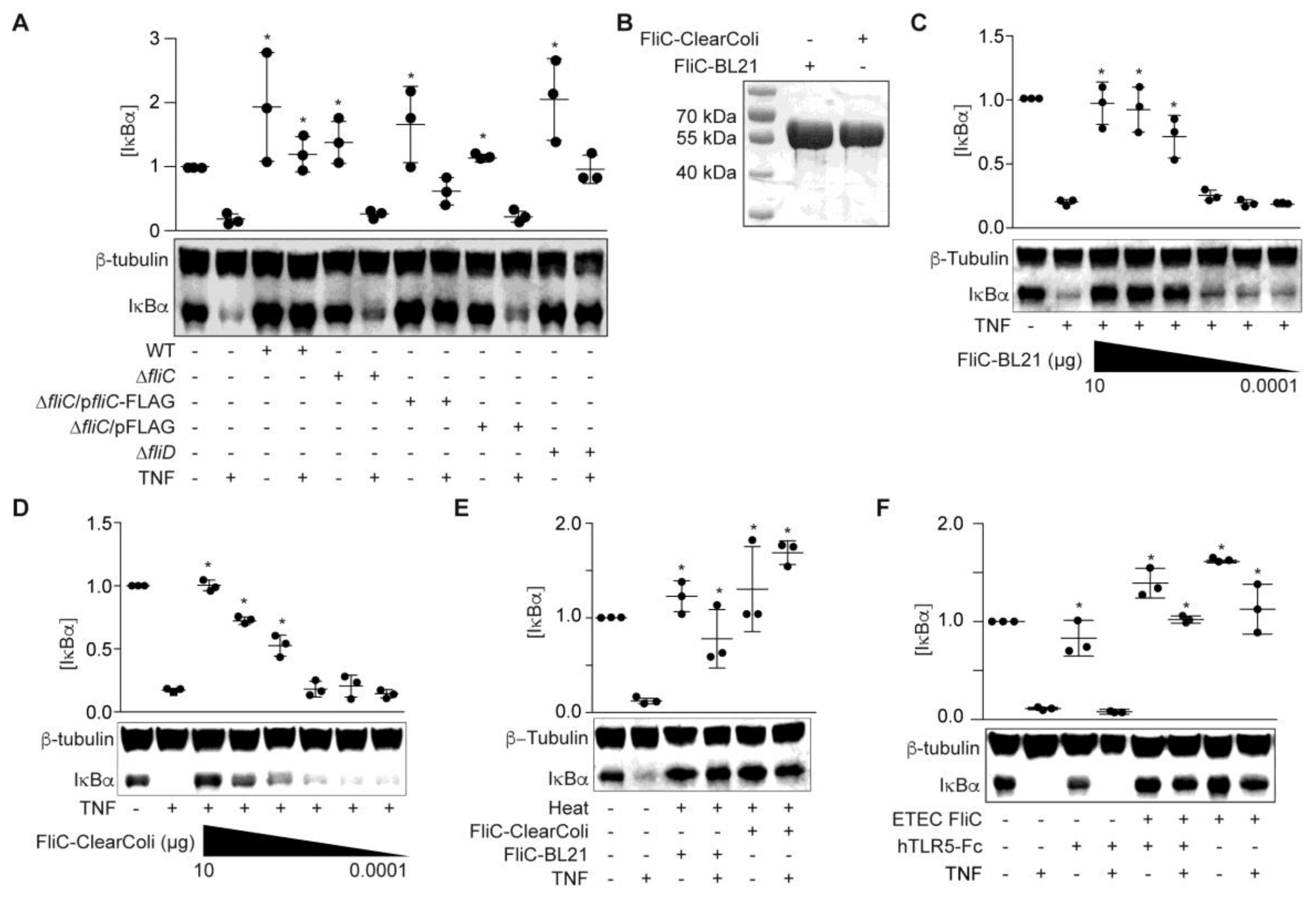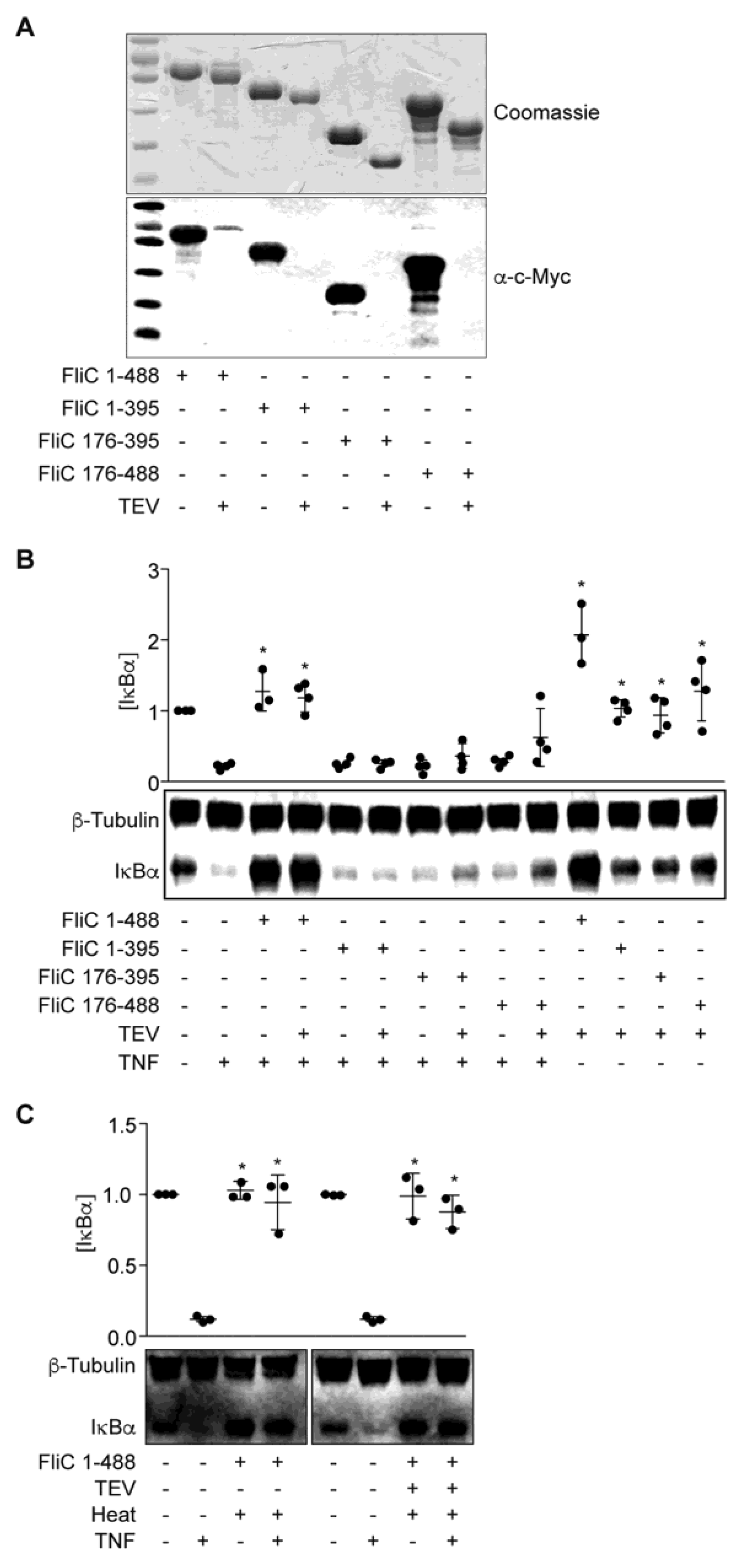Enterotoxigenic Escherichia coli Flagellin Inhibits TNF-Induced NF-κB Activation in Intestinal Epithelial Cells
Abstract
:1. Introduction
2. Results and Discussion
2.1. ETEC H10407 Secretes ESF into M9 Minimal Media
2.2. ETEC Flagellin Blocks TNF-Induced IκBα Degradation
2.3. FliC Domain Mapping
2.4. Intracellular Expression of fliC Fails to Block IκBα Degradation in Response to TNFα
3. Materials and Methods
3.1. Reagents and Antibodies
3.2. Bacterial Strains and Plasmids
3.3. Cell Lines and Culture Conditions
3.4. ETEC Supernatant
3.5. Fast Protein Liquid Chromatography and Mass Spectrometry
3.6. Construction of ETEC H10407 Mutants
3.7. Recombinant Protein Expression and Purification
3.8. Transfection
3.9. Immunoblotting
3.10. Statistical Analysis
Acknowledgments
Author Contributions
Conflicts of Interest
Abbreviations
| ETEC | enterotoxigenic Escherichia coli |
| LT | heat-labile enterotoxin |
| NF-κB | nuclear factor-κB |
| ST | heat-stable enterotoxin |
| TNFα | tumor necrosis factor α |
References
- Qadri, F.; Svennerholm, A.M.; Faruque, A.S.; Sack, R.B. Enterotoxigenic Escherichia coli in developing countries: Epidemiology, microbiology, clinical features, treatment, and prevention. Clin. Microbiol. Rev. 2005, 18, 465–483. [Google Scholar] [CrossRef] [PubMed]
- Giddings, S.L.; Stevens, A.M.; Leung, D.T. Traveler’s Diarrhea. Med. Clin. N. Am. 2016, 100, 317–330. [Google Scholar] [CrossRef] [PubMed]
- Fleckenstein, J.M.; Hardwidge, P.R.; Munson, G.P.; Rasko, D.A.; Sommerfelt, H.; Steinsland, H. Molecular mechanisms of enterotoxigenic Escherichia coli infection. Microbes Infect. 2010, 12, 89–98. [Google Scholar] [CrossRef] [PubMed]
- Madhavan, T.P.; Sakellaris, H. Colonization factors of enterotoxigenic Escherichia coli. Adv. Appl. Microbiol. 2015, 90, 155–197. [Google Scholar] [PubMed]
- Huang, D.B.; DuPont, H.L.; Jiang, Z.D.; Carlin, L.; Okhuysen, P.C. Interleukin-8 response in an intestinal HCT-8 cell line infected with enteroaggregative and enterotoxigenic Escherichia coli. Clin. Diagn. Lab. Immunol. 2004, 11, 548–551. [Google Scholar] [CrossRef] [PubMed]
- Haiko, J.; Westerlund-Wikstrom, B. The role of the bacterial flagellum in adhesion and virulence. Biology (Basel) 2013, 2, 1242–1267. [Google Scholar] [CrossRef] [PubMed]
- Zhou, M.X.; Duan, Q.D.; Zhu, X.F.; Guo, Z.Y.; Li, Y.C.; Hardwidge, P.R.; Zhu, G.Q. Both flagella and F4 fimbriae from F4ac(+) enterotoxigenic Escherichia coli contribute to attachment to IPEC-J2 cells in vitro. Vet. Res. 2013, 44, 30. [Google Scholar] [CrossRef] [PubMed]
- Zhou, M.X.; Guo, Z.Y.; Yang, Y.; Duan, Q.D.; Zhang, Q.; Yao, F.H.; Zhu, J.; Zhang, X.J.; Hardwidge, P.R.; Zhu, G.Q. Flagellin and F4 fimbriae have opposite effects on biofilm formation and quorum sensing in F4ac+enterotoxigenic Escherichia coli. Vet. Microbiol. 2014, 168, 148–153. [Google Scholar] [CrossRef] [PubMed]
- Roy, K.; Hilliard, G.M.; Hamilton, D.J.; Luo, J.W.; Ostmann, M.M.; Fleckenstein, J.M. Enterotoxigenic Escherichia coli EtpA mediates adhesion between flagella and host cells. Nature 2009, 457, 594–598. [Google Scholar] [CrossRef] [PubMed]
- Lawrence, T. The nuclear factor NF-kappaB pathway in inflammation. Cold Spring Harb. Perspect. Biol. 2009, 1, a001651. [Google Scholar] [CrossRef] [PubMed]
- Karin, M.; Ben-Neriah, Y. Phosphorylation meets ubiquitination: The control of NF-[kappa]B activity. Annu. Rev. Immunol. 2000, 18, 621–663. [Google Scholar] [CrossRef] [PubMed]
- Yin, Q.; Fu, T.M.; Li, J.; Wu, H. Structural biology of innate immunity. Annu. Rev. Immunol. 2015, 33, 393–416. [Google Scholar] [CrossRef] [PubMed]
- Reddick, L.E.; Alto, N.M. Bacteria Fighting Back: How Pathogens Target and Subvert the Host Innate Immune System. Mol. Cell 2014, 54, 321–328. [Google Scholar] [CrossRef] [PubMed]
- Wang, X.; Hardwidge, P.R. Enterotoxigenic Escherichia coli prevents host NF-kappaB activation by targeting IkappaBbalpha polyubiquitination. Infect. Immun. 2012, 80, 4417–4425. [Google Scholar] [CrossRef] [PubMed]
- Planesse, C.; Nativel, B.; Iwema, T.; Gasque, P.; Robert-Da Silva, C.; Viranaicken, W. Recombinant human HSP60 produced in Clearcoli (TM) BL21(DE3) does not activate the NF kappa B pathway. Cytokine 2015, 73, 190–195. [Google Scholar] [CrossRef] [PubMed]
- Maki-Yonekura, S.; Yonekura, K.; Namba, K. Conformational change of flagellin for polymorphic supercoiling of the flagellar filament. Nat. Struct. Mol. Biol. 2010, 17, 417–422. [Google Scholar] [CrossRef] [PubMed]
- Li, H.X.; Lin, X. Positive and negative signaling components involved in TNF alpha-induced NF-kappa B activation. Cytokine 2008, 41, 1–8. [Google Scholar] [CrossRef] [PubMed]
- Fotin-Mleczek, M.; Welte, S.; Mader, O.; Duchardt, F.; Fischer, R.; Hufnagel, H.; Scheurich, P.; Brock, R. Cationic cell-penetrating peptides interfere with TNF signalling by induction of TNF receptor internalization. J. Cell Sci. 2005, 118, 3339–3351. [Google Scholar] [CrossRef] [PubMed]
- Evans, D.G.; Silver, R.P.; Evans, D.J., Jr.; Chase, D.G.; Gorbach, S.L. Plasmid-controlled colonization factor associated with virulence in Escherichia coli enterotoxigenic for humans. Infect. Immun. 1975, 12, 656–667. [Google Scholar] [PubMed]
- Geisbrecht, B.V.; Bouyain, S.; Pop, M. An optimized system for expression and purification of secreted bacterial proteins. Protein Expr. Purif. 2006, 46, 23–32. [Google Scholar] [CrossRef] [PubMed]
- Datsenko, K.A.; Wanner, B.L. One-step inactivation of chromosomal genes in Escherichia coli K-12 using PCR products. Proc. Natl. Acad. Sci. USA 2000, 97, 6640–6645. [Google Scholar] [CrossRef] [PubMed]
- Gao, X.F.; Wan, F.Y.; Mateo, K.; Callegari, E.; Wang, D.; Deng, W.Y.; Puente, J.; Li, F.; Chaussee, M.S.; Finlay, B.B.; et al. Bacterial Effector Binding to Ribosomal Protein S3 Subverts NF-kappa B Function. PLoS Pathog. 2009, 5, e1000708. [Google Scholar] [CrossRef] [PubMed]




| Protein Candidates | Sequence Coverage | Identity to E. coli MG1655 | GenBank Accession # |
|---|---|---|---|
| Major outer membrane lipoprotein | 49% over 78 AAs | 100% | CBJ00536.1 |
| Outer membrane protein A | 26% over 346 AAs | 99% | CBJ01214.1 |
| Flagellar hook-associated protein 2 (FliD) | 44% over 470 AAs | 50% | CBJ01536.1 |
| Flagellin (FliC) | 71% over 487 AAs | 52% | CBJ01535.1 |
| Strain or Plasmid | Description | Source or Reference |
|---|---|---|
| Strains | ||
| ETEC H10407 | O78:H11, CFA/I, LT+ and ST+ | [19] |
| E. coli DH5α | Cloning strain | New England BioLabs |
| E. coli BL21 (DE3) | Protein overexpression strain | Novagen |
| ClearColi BL21 (DE3) | Protein overexpression | Lucigen |
| ETEC ΔfliC | ETEC H10407 fliC mutant | This study |
| ETEC ΔfliD | ETEC H10407 fliD mutant | This study |
| ETEC ΔfliC/pFliC-FLAG | ETEC H10407 ΔfliC complemented with fliC | This study |
| Plasmids | ||
| pFLAG-CTC | FLAG-tagged protein expression | Sigma |
| pET28a | His6 fusion protein expression | Novagen |
| pT7HMT | His6 fusion protein expression with TEV site | [20] |
| pKD3 | Template for mutagenic PCR products | [21] |
| PKD46 | Lambda Red mediated mutagenesis | [21] |
| pCMV | Mammalian expression vector with HA-tag | [22] |
| pET28a-FliC | FliC in pET28a | This study |
| pT7HMT-FliC | FliC in pT7HMT | This study |
| pT7HMT-FliC (176–395) | FliC (176–395) in pT7HMT | This study |
| pT7HMT-FliC (1–395) | FliC (1–395) in pT7HMT | This study |
| pT7HMT-FliC (176–488) | FliC (176–488) in pT7HMT | This study |
| pCMV-FliC (1–487) | FliC (1–487) in pCMV | This study |
| pCMV-FliC (176–395) | FliC (176–395) in pCMV | This study |
| pCMV-FliC (1–395) | FliC (1–395) in pCMV | This study |
| pCMV-FliC (176–487) | FliC (176–487) in pCMV | This study |
| pCMV-FliC (2–395) | FliC (2–395) in pCMV | This study |
| pCMV-FliC (2–487) | FliC (2–487) in pCMV | This study |
| Primer | Purpose | Sequence (5′-3′) |
|---|---|---|
| PRH-3427 | Delete ETEC H10407 fliD | A2T2GC2GATA2C3GCT2ATCTACTGT3GCA2TC |
| A4G2A2T2AG2TGTGTA2CTG2AGCTGCT2C | ||
| PRH-3428 | Delete ETEC H10407 fliD | T2GTGCATAG2CT4GAGC2GCTCGCG2TATAC |
| ATGCTGAC2TC2GTGA2TG3A2T2AGC2ATG2TC2 | ||
| PRH-3429 | Verify fliD deletion | TCTCTC2TGT6CT2A2CG2CT |
| PRH-3430 | Verify fliD deletion | GCTGAT2GT2GTC2TGCATA3CA |
| PRH-3431 | Delete ETEC H10407 fliC | CGTG3CA2CAGC3A2TA2CATCA2GT2GTA2T2GA |
| TA2G2A4GATCGTGTAG2CTG2AGCTGCT2C | ||
| PRH-3432 | Delete ETEC H10407 fliC | GCG3CAGA6C4GC2G2TG2CG5T2GAGCGA |
| TA2GTGTA4TG3A2T2AGC2ATG2TC2 | ||
| PRH-3433 | Verify fliC deletion | ATGATGCGCAGAGTAGAGT2GTAT |
| PRH-3434 | Verify fliC deletion | ATGAT2ATC2GT3CTGCAG3T2 |
| PRH-3619 | Clone fliC pCMV-XhoI | TAC2GCTCGAGATG2CACA2GTCAT2A2TA |
| PRH-3620 | Clone fliC pCMV-NotI | ATA2GA2TGCG2C2GCACGCAGCAGAGACAGTA |
| PRH-3681 | Clone fliC pET28a-Nde I | GGA2T2C2ATATG2CACA2GTCAT2A2TACA |
| PRH-3682 | Clone fliC pET28a-XhoI | TAC2GCTCGAGACGCAGCAGAGACAGTA |
| PRH-3684 | Clone fliC pFLAG-CTC-XhoI | TAC2GCTCGAG2CACA2GTCAT2A2TA |
| PRH-3685 | Clone fliC pFLAG-CTC-BglII | G2A2GATCTACGCAGCAGAGACAGTA |
| PRH-3788 | Clone fliC 176-395 pCMV-XhoI | TATAT2ACTCGAG2ATG2CGCGCAGA3GCA2 |
| PRH-3789 | Clone fliC 176-395 pCMV-NotI | ATA2GA2TGCG2C2GCT2GCA2CGAT4 |
| PRH-3543 | Clone fliC pT7HMT-BamHI | TACGCG2ATC2ATG2CACA2GTCAT2A2TACA2 |
| PRH-3844 | Clone fliC pT7HMT-NotI | ATA2GAT2GCG2C2GCT2A2CGCAGCAGAGA |
| PRH-3845 | Clone fliC 176-395 pT7HMT-BamHI | TACGCG2ATC2GATG2CGCGCAGA3 |
| PRH-3851 | Clone fliC 176-395 pT7HMT-NotI | ATA2GAT2GCGGC2GCTCAT2GCA2CGAT4 |
| PRH-3971 | Clone fliC pCMV-XhoI | TAC2GCTCGAG2CACA2GTCAT2A2TACA3CAGC2 |
© 2017 by the authors. Licensee MDPI, Basel, Switzerland. This article is an open access article distributed under the terms and conditions of the Creative Commons Attribution (CC BY) license (http://creativecommons.org/licenses/by/4.0/).
Share and Cite
Wang, G.; Geisbrecht, B.V.; Rueter, C.; Hardwidge, P.R. Enterotoxigenic Escherichia coli Flagellin Inhibits TNF-Induced NF-κB Activation in Intestinal Epithelial Cells. Pathogens 2017, 6, 18. https://doi.org/10.3390/pathogens6020018
Wang G, Geisbrecht BV, Rueter C, Hardwidge PR. Enterotoxigenic Escherichia coli Flagellin Inhibits TNF-Induced NF-κB Activation in Intestinal Epithelial Cells. Pathogens. 2017; 6(2):18. https://doi.org/10.3390/pathogens6020018
Chicago/Turabian StyleWang, Gaochan, Brian V. Geisbrecht, Christian Rueter, and Philip R. Hardwidge. 2017. "Enterotoxigenic Escherichia coli Flagellin Inhibits TNF-Induced NF-κB Activation in Intestinal Epithelial Cells" Pathogens 6, no. 2: 18. https://doi.org/10.3390/pathogens6020018






